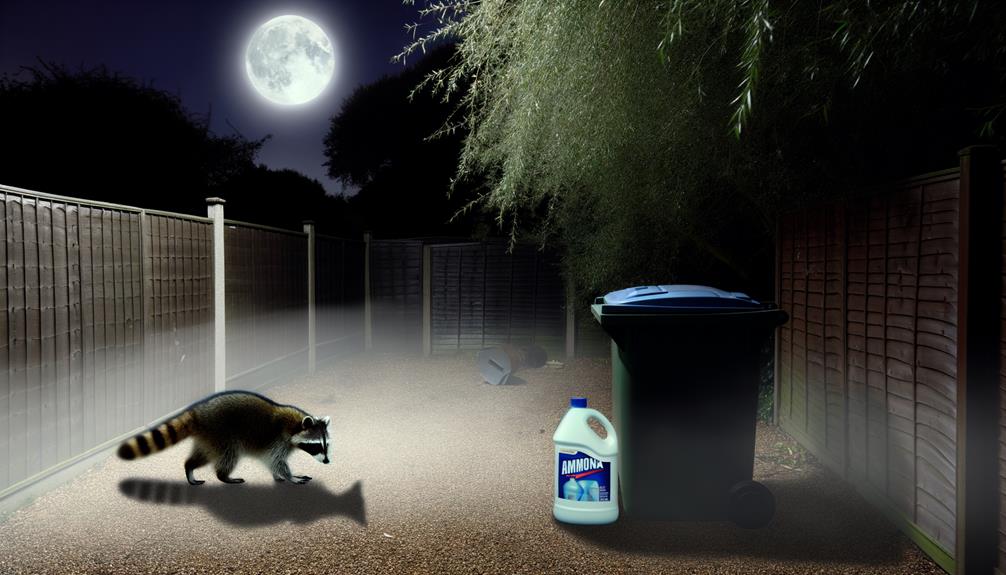Does Ammonia Keep Raccoons Away: A Step-by-Step Guide
Ammonia can deter raccoons due to its pungent smell and irritant properties. The chemical makeup of ammonia, made up of nitrogen and hydrogen, disrupts raccoons' sense of smell and causes irritation to their mucous membranes.
This decreases their chances of visiting treated areas. However, using ammonia safely requires understanding its volatility and proper handling techniques, including the use of personal protective gear and ensuring there is enough ventilation.
While ammonia may be effective short-term, it is important to think about long-term solutions for human-wildlife conflict management. For a thorough approach to managing raccoon deterrence and understanding the associated risks, further exploration is necessary.

Key Takeaways
- Ammonia's pungent odor disrupts raccoons' olfactory receptors, making the area less attractive to them.
- Ammonia-soaked rags placed near entry points can act as a deterrent for raccoons.
- Raccoons find the smell of ammonia irritating, reducing their visitation to treated areas.
- The volatility of ammonia ensures it disperses effectively, covering larger areas quickly.
- Using ammonia safely involves proper ventilation, PPE, and adherence to storage guidelines to prevent hazards.
Understanding Raccoon Behavior
Raccoon behavior, characterized by their nocturnal activity and adaptability to various environments, provides critical insights into their interactions with both natural and urban ecosystems.
These omnivorous mammals exhibit remarkable problem-solving skills, allowing them to exploit diverse food sources ranging from fruits and insects to human waste.
Their dexterous forepaws enhance their ability to manipulate objects and access confined spaces.
In urban settings, raccoons are known to infiltrate garbage bins and attics, often leading to human-wildlife conflicts.
Understanding these behavioral patterns is essential for developing effective management strategies that minimize negative interactions, ensuring both human safety and animal welfare.
Their adaptability underscores the importance of considering ecological and behavioral factors when addressing raccoon-related issues in various environments.
How Ammonia Works
Ammonia, a compound composed of nitrogen and hydrogen (NH3), operates as an effective raccoon deterrent through its pungent odor, which raccoons find intolerable.
The chemical composition of ammonia facilitates its volatility, allowing it to disperse easily in the environment.
This dispersion mechanism is vital in repelling raccoons by overwhelming their sensitive olfactory systems.
Chemical Composition Analysis
Understanding the chemical composition of ammonia requires a thorough analysis of its molecular structure, which consists of one nitrogen atom covalently bonded to three hydrogen atoms.
This simple yet potent molecule, represented by the formula NH₃, is a colorless gas with a distinct, pungent odor. The nitrogen atom has a lone pair of electrons, contributing to ammonia's basicity, which allows it to accept protons readily.
Its polar nature and hydrogen bonding capabilities render it highly soluble in water, forming ammonium hydroxide. In its gaseous state, ammonia exhibits high volatility, making it effective in dispersing quickly into the environment.
These chemical properties are essential for understanding how ammonia interacts with biological systems, including potential applications for pest control.
Repellent Mechanism Explained
By leveraging its strong odor and irritant properties, ammonia disrupts the sensory receptors of raccoons, thereby functioning effectively as a repellent. The pungent smell of ammonia is detected by raccoons' highly sensitive olfactory system, causing discomfort and disorientation. This aversive reaction reduces the likelihood of raccoons frequenting areas treated with ammonia. Additionally, the chemical can cause mild mucous membrane irritation, further deterring their presence.
| Property | Effect on Raccoons |
|---|---|
| Strong Odor | Disrupts olfactory receptors |
| Irritant Properties | Causes mucous membrane irritation |
| Disorientation | Reduces area visitation |
This mechanism not only serves to protect human habitats but also minimizes the need for more invasive control methods, aligning with humane wildlife management practices.
Using Ammonia Safely
To secure safe use of ammonia, it is critical to understand its chemical properties and potential hazards. Ammonia (NH3) is a colorless gas with a pungent odor, commonly used in cleaning agents and fertilizers.
When handling ammonia, utilize personal protective equipment (PPE) such as gloves and goggles to prevent skin and eye irritation. Maintain proper ventilation in the area by opening windows or using fans, as inhalation of ammonia fumes can lead to respiratory issues.
Store ammonia in a cool, dry place away from incompatible substances, particularly acids, which can cause dangerous reactions. Always follow manufacturer guidelines and local regulations to minimize risk.
Employing these precautions guarantees not only personal safety but also the safety of others in the vicinity.
Effectiveness of Ammonia
Frequently lauded for its versatility, ammonia proves to be highly effective in various applications ranging from household cleaning to agricultural fertilization. Its pungent odor is often cited as a deterrent for raccoons, who possess a highly sensitive sense of smell. Scientific observations indicate that raccoons tend to avoid areas treated with ammonia, suggesting its potential as a non-toxic repellent. However, empirical data on its effectiveness are varied and dependent on concentration and environmental factors.
| Application | Effectiveness |
|---|---|
| Household Cleaning | Highly Effective |
| Agricultural Fertilization | Highly Effective |
| Raccoon Deterrent | Variable |
| General Pest Deterrent | Moderately Effective |
Further research is needed to quantify its efficacy as a raccoon deterrent conclusively.
Risks of Using Ammonia
Despite its widespread applications, the use of ammonia carries several risks that require careful consideration and management. Ammonia is a volatile compound, and its strong odor can cause respiratory irritation in humans and pets. When inhaled, it may lead to coughing, wheezing, and in severe cases, respiratory distress.
Direct contact with concentrated ammonia can result in skin burns and eye irritation. Additionally, ammonia poses environmental hazards; when released into water systems, it can disrupt aquatic ecosystems by increasing nitrogen levels, leading to algal blooms and oxygen depletion.
Proper storage and handling are essential to mitigate these risks. Ensuring that ammonia is used in well-ventilated areas and avoiding direct exposure can help protect both human health and the environment.
Alternative Deterrents
Considering the potential hazards associated with ammonia, exploring alternative deterrents for raccoons is essential for ensuring safety and environmental sustainability.
Several non-toxic methods can effectively dissuade raccoons without compromising human or ecological health.
- Motion-Activated Sprinklers: These devices detect movement and release bursts of water, startling raccoons and encouraging them to leave the area.
- Ultrasonic Repellents: Emitting high-frequency sounds, these devices are inaudible to humans but disturb raccoons, making the environment less appealing.
- Natural Repellents: Substances such as predator urine or strong-smelling plants (e.g., peppermint) can be strategically placed to create an inhospitable environment for raccoons.
These alternatives provide humane and eco-friendly solutions for raccoon deterrence, aligning with a commitment to serve and protect both communities and wildlife.
Long-Term Solutions
To achieve lasting raccoon deterrence, it is crucial to implement long-range strategies that address the root causes of raccoon attraction and habitat suitability.
First, secure garbage bins with snug-fitting lids and store them indoors if possible to eliminate food sources.
Second, remove outdoor pet food and bird feeders that could lure raccoons.
Third, seal entry points to attics, basements, and crawl spaces to prevent nesting.
Additionally, maintain landscaping by trimming trees and shrubs to reduce shelter opportunities.
Using motion-activated sprinklers and lights can further discourage raccoons.
Finally, educate the community about these measures to ensure collective efforts in minimizing raccoon presence.
Through these thorough, sustainable practices, a raccoon-free environment can be effectively maintained.
Conclusion
To wrap up, while ammonia may act as a temporary raccoon deterrent, its effectiveness is not assured, and the related dangers can be significant. The chemical's strong smell could deter these persistent creatures temporarily, but raccoons are known for their adaptability and might eventually become immune to it.
Besides, the risky characteristics of ammonia require careful handling, emphasizing the importance of safer, substitute deterrents. Ultimately, thorough, long-lasting strategies are crucial for successfully managing raccoon intrusion and guaranteeing sustainable wildlife control.






